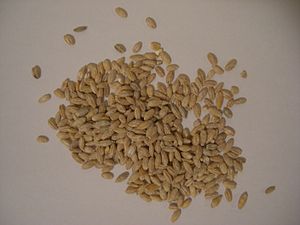 Image by freefotouk via FlickrAmong the early Greeks and Romans, barley was almost the only food of the common people and the soldiers. The flour was made into gruel, after the following recipe: "Dry, near the fire or in the oven, twenty pounds of barley flour, then parch it. Add three pounds of linseed meal, half a pound of coriander seeds, two ounces of salt, and the water necessary." If an especially delectable dish was desired, a little millet was also added to give the paste more "cohesion and delicacy." Barley was also used whole as a food, in which case it was first parched, which is still the manner of preparing it in some parts of Palestine and many districts of India, also in the Canary Islands, where it is known as gofio .
Image by freefotouk via FlickrAmong the early Greeks and Romans, barley was almost the only food of the common people and the soldiers. The flour was made into gruel, after the following recipe: "Dry, near the fire or in the oven, twenty pounds of barley flour, then parch it. Add three pounds of linseed meal, half a pound of coriander seeds, two ounces of salt, and the water necessary." If an especially delectable dish was desired, a little millet was also added to give the paste more "cohesion and delicacy." Barley was also used whole as a food, in which case it was first parched, which is still the manner of preparing it in some parts of Palestine and many districts of India, also in the Canary Islands, where it is known as gofio . In the time of Charles I, barley meal took the place of wheat almost entirely as the food of the common people in England. In some parts of Europe, India, and other Eastern countries, it is still largely consumed as the ordinary farinaceous food of the peasantry and soldiers. The early settlers of New England also largely used it for bread making.
Barley is less nutritious than wheat, and to many people is less agreeable in flavor (although others prefer it). It is likewise somewhat inferior in point of digestibility. Its starch cells being less soluble, they offer more resistance to the gastric juice.
 Image via WikipediaThere are several distinct species of barley, but that most commonly cultivated is designated as two-rowed, or two-eared barley. In general structure, the barley grain resembles wheat and oats.
Image via WikipediaThere are several distinct species of barley, but that most commonly cultivated is designated as two-rowed, or two-eared barley. In general structure, the barley grain resembles wheat and oats. Simply deprived of its outer husk, the grain is termed Scotch milled or pot barley . Subjected still further to the process by which the fibrous outer coat of the grain is removed, it constitutes what is known as pearl barley . Pearl barley ground into flour is known as patent barley. Barley flour, owing to the fact that it contains so small a proportion of gluten, needs to be mixed with wheaten flour for bread-making purposes. When added in small quantity to whole-wheat bread, it has a tendency to keep the loaf moist, and is thought by some to improve the flavor.
The most general use made of this cereal as a food, is in the form of pearl, or Scotch, barley. When well boiled, barley requires about two hours for digestion.

No comments:
Post a Comment
We welcome comments and suggestions!